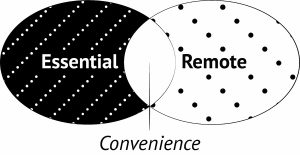Pandemic Platforms: How Convenience Shapes the Inequality of Crisis
This article examines how digital platforms responded to the COVID-19 crisis, showing how “pandemic platforms” exploit the present intersection of convenience and necessity. During the pandemic, platforms provide convenience-turned-necessity for stay-at-home consumers, even as platforms made use of stay-at-home orders to further exploit (and put at risk) their workforce. What we show are that convenience and risk are two sides of the same coin, shaping how platforms based on a logic of intermediation further entrench themselves during the pandemic. This requires media studies to turn its attention towards the logic of intermediation, organization, and pandemic mediations to account for the ways platforms exploit the current crisis to further entrench themselves via a combined appeal to convenience and risk.
Pandemic platforms can be understood through the convergence of two bubbles. The first is a speculative bubble that gave rise to the monopolistic platforms that have come to dominate digital life. This financial bubble begins with the dot.com boom and bust of the late 1990s, and resurged post-2009, when high risk and rapid return investments in tech companies transformed the industry by prioritizing speculative ventures over the long-term viability or utility of start-ups (Srnicek 2016). Indeed the term “start-up” captures the very logic of financial bubbles. The dot.com crash forced companies to find new avenues to profitability, shaping ad-driven data mining, on the one hand, and the e-commerce giants that dominate the platform economy today, on the other. The second bubble is based on personal health and public safety and encapsulates people’s everyday activities during the COVID-19 crisis—albeit in sharply different ways. This idea of the “bubble” has quickly become a dominant metaphor for coronavirus-era co-isolation and co-habitation, such as health and travel bubbles, pandemic pods, and quaranteams. Canada’s deputy health officer even framed one’s personal space in those terms as he advised the nation to “stay in your bubble” (“‘Stay in Your Bubble’” 2020). But while pandemic bubbles are popularly tied to health and security, it is also clear that they can be deeply hazardous—including screen fatigue and addiction, isolation and depression, and problems of access, attention, and ableism (Ginsburg, Mills, and Rapp 2020).
The speculative bubble produces the platform economy; the pandemic bubble remakes and intensifies aspects of it, with financial analysts like Royal Bank of Canada’s John Stackhouse going so far as to call this the “platform pandemic” (Stackhouse 2020). In what follows, we briefly examine how platformed life is transformed by the current crisis, focusing on the relationship between essential services and the experience of convenience (consumers), and how this notion of convenience generates risk and exposure for those who work to produce it (laborers).
There are two general models for understanding platforms. The first view, common in media studies, understands platforms as a base that supports social media and related activities: YouTube, Twitter, Twitch, Facebook, etc. The second model is as an economic intermediary between two people or entities to facilitate financial transactions (Eisenmann, Parker, and Alstyne 2006; Kokuryō 1994; Steinberg 2019). Since the 2000s, transactional platforms like the FAANG (Facebook, Amazon, Apple, Netflix, Google) and BAT (Baidu, Alibaba, Tencent) giants, among many others, have become intermediaries for everyday exchange, displacing newspapers, ad agencies, film theatres, booksellers, department stores, cloud providers, taxis, hotels, and much else.
What platform intermediaries provide consumers is convenience. The convenience of not going to a video store; of not re-entering credit card information for every transaction; of calling a driver to your home with an app; of internet-mediated transactions of all types. Tim Wu has described convenience in the twenty-first century as “more efficient and easier ways of doing personal tasks” and “perhaps the most powerful force shaping our individual lives and our economies” (Wu 2018). Convenience is, of course, a historically relative concept (Tierney 1993). Convenience is produced by a space-time compression that gives rise to a feeling of ease linked historically to “increasing pressures of time” and tied to the historical rise of the consumer society (Shove 2003, 22). Convenience is also what Sianne Ngai would call an “aesthetic category” (Ngai 2012), one whose parameters change according to the era in question. As mobilized here, convenience is more specifically tied to the lure of immediacy offered by tech companies; the “prominent promise of convenience, with its emphasis on immediacy and instant gratification” (Appadurai and Alexander 2020, 21) that Appardurai and Alexander find at the heart of the appeal of Silicon Valley companies and their platforms. Indeed, convenience is crucial to how platforms disrupt existing industries and carve out new revenue streams for big tech. But amid critiques of data extraction and surveillance capitalism (Andrejevic 2009; Zuboff 2019), less attention has been given to how convenience structures the consumption or production sides of the platform economy—an issue that is exacerbated by the COVID crisis.
[Fig. 1] Pandemic platforms make convenience essential (Source: Neves & Steinberg 2020, image design by Teagan Lance)
The COVID pandemic transforms our relationship to platforms and to convenience by expanding and normalizing the protective bubble (distancing, sheltering, quarantine, etc.). This bubble brings with it two sets of distinctions that reorder our everyday activities:
- Essential vs. non-essential (workers, tasks, items)
- Remote vs. in-person (work, services, interactions).
In this context, activities that are both remote and essential take the place of most in-person activities, like going to work or to the grocery store, which are further shifted onto platforms (Fig. 1). This is to observe an important transformation: what was merely convenient just a few months ago has become infrastructural to everyday life for many people. Put differently, this intersection recasts convenience as an essential or necessary service. The impact of this shift for digital platforms is crucial and divisive. For the quarantined and the vulnerable, pandemic platforms emerged as basic services providing access and delivery of food, medicine, household items, TV and movies (streaming), and contact with loved ones, students, and coworkers (e.g. Zoom). In an era of contagion, remoteness and the absence of human touch is at a premium, and many platform intermediaries are well positioned to provide essential services at a distance. Amazon, as one person close to the company puts it, is presenting itself as the new Red Cross (Lee and Nilsson 2020).
[Fig. 2] Essential and in-person platforms produce risk and exposure (Source: Neves & Steinberg 2020, image design by Teagan Lance)
But the conflation of the essential and the convenient also obscures much about pandemic platforms. Not only does this pervasive discourse understand platforms from the perspective of distancing and privileged consumers—those who use contactless services to order, receive, and rate—but it diminishes how the production of convenience itself generates inequality and vulnerability. There are, of course, important reasons to ensure essential services and minimize human contact. This is not in dispute. What concerns us here is how pandemic platforms exploit essential and in-person labor (see figure 2) in ways that intensify risk and exposure (e.g. for grocery clerks, nurses, warehouse and delivery workers) and contribute to the consolidation of the platform industry. A recent headline captures the situation: “The Economy is Reeling. The Tech Giants Spy Opportunity” (Isaac 2020). Instead we need to re-ask an old question: who produces convenience and who consumes it, and under what conditions? In this way, the current crisis both makes visible already-existing precarity—Amazon warehouses, the gig economy, platform-mediated contract workers (Chen and Sun 2020; Scholz 2017)—and intensifies gigification and self-responsibility by using the crisis to make this work essential. It also presents new opportunities for political dissent and worker organization, not least of which were strikes by Amazon and Instacart workers (Lerman and Tiku 2020).
As platformed convenience becomes the new normal amidst an ethical requirement to flatten the curve and ensure access to basics, a few companies have emerged as the lead providers of essential-remote services. From the perspective of pandemic media, key platforms like Amazon, Microsoft, Netflix, WhatsApp, and Zoom play an outsized role in shaping everyday life (in North America and beyond). Zoom, in particular, is a crucial example of what we are calling pandemic platforms. In the span of a few months, it has shifted from a niche subscription service to a basic infrastructure used for work, happy hours, and even funerals. In December 2019, Zoom had a user base of 10 million. By April 2020, Zoom claims it has “300 million daily meeting participants” (Warren 2020). It has gone from a minor software to become a proprietary eponym and a verb: let’s Zoom.
Zoom (like Slack, Teams, and others) brings renewed attention to teleworking, now expanded well beyond tech jobs and privileged digital nomads, as an everyday necessity (Gregg 2013). This includes, in many areas, a crucial role for live and asynchronous video for a wide range of jobs—from telemedicine to teaching. In terms of higher education, and the work of media studies in particular, it’s a moment when the object of study also becomes an infrastructural condition. This is also to pressure the conceptual distinction, suggested above, separating consumers and producers in the platform economy. For all its analytic utility (Qiu, Gregg, and Crawford 2014), this separation begs the question of how to parse the range of activities carried out on platforms like Zoom: academics produce course content, use the platform to attend meetings and conferences, hold office hours, conduct research (as in the current fascination with remote ethnography), and even form personal relationships. Students by the same token both watch Zoom and also regularly generate their own content and uses.
[Fig. 3] The “I Yield My Time” meme speaks to the rapid significance of Zoom and the ways that media platforms penetrate all aspects of life during the COVID crisis. (Source: Screengrab from YouTube video)
The rise of platforms like Zoom also points to the further outsourcing of public services to consumer platforms. On the one hand, even commercial platforms like Instagram and WhatsApp have allowed for local communities to organize groceries for the elderly, among other community projects. On the other hand, the current crisis has enabled multinational corporations to extend their influence across traditional social sectors, including health care (Apple and Google’s contact tracing apps), education (Zoom), postal delivery (Amazon), news and public information (Facebook Live), and much else besides. Even public hearings take place on private platforms, exemplified perhaps by the LA Police Department’s virtual community meeting gone viral video (Figure 3). These interventions, which intensify changes already underway, demand that we turn our attention to how the platform economy seeks to reorder society. We must not only guard against the Uberization of social care and neighborhood life, but also refuse to let these industries set the terms for how we inhabit and respond to the current crisis.
This brief consideration of pandemic platforms has two general takeaways for COVID-era media critique. The first is that media studies has much to gain by thinking across platforms and not just those that deliver media content (Netflix, YouTube, Facebook). Instead, platforms’ unique mode of intermediation cuts across multiple sectors—from online ordering to video streaming to health monitoring. This includes, as we have suggested here, the ways that convenience and risk are conflated by the logistical operations of the current crisis. Second, beyond the question of production and consumption that we emphasize above, platform mediation also turns our attention to the centrality of distribution and logistics (Cowen 2014; Lovink and Rossiter 2018). In this context, media/platforms, understood as “civilizational ordering devices,” play a critical role in administering our experience and understanding of crisis (Peters 2015, 5).
The consequences of intensifying platformed convenience (as both remote and essential) for our everyday habits and social operations will endure long after the coronavirus goes the way of the Spanish flu or becomes a new normal. More than ever we need critical media perspectives that examine how crises—of health, but also economic, political, racial, etc.—shape the platformed convenience that unevenly distributes basic services and risk media society (Neves 2020). This includes, as is forcefully traced in the Pirate Care syllabus, the growing gap between care and negligence at the heart of the current crisis (Fragnito et. al. 2020). Here we rely on both quotidian and concrete understandings of crisis—especially the experiences and mediations of everyday life during the coronavirus pandemic—as well as the fact that critique itself derives from the Greek krisis. As Wendy Brown puts it, “the project of critique is to set the times right again by discerning and repairing a tear in justice through practices that are themselves exemplary of the justice that has been rent” (Brown 2005, 6). Addressing crisis is central to the critical project itself, and hence to deepen critique from within platform studies also requires that we attend to how platforms seize moments of crisis to reconfigure the social. This involves connecting the political sense of crisis to its more recent technological consolidation. To rework Wendy Hui Kyong Chun’s critique of networked technologies, in Updating to Remain the Same, that “habit + crisis = update” (Chun 2016), we might say that: platforms + crisis = inequality. That is, pandemic platforms produce convenience for some, hazard for others, and financial consolidation for elites. In many regards this is a familiar story of exploitation and crisis. What is perhaps new about this mode of organization and extraction is the role of media platforms in redistributing convenience and necessity. Platform monopolies will just be waiting for the next crisis-bubble to work this equation again.
References
Andrejevic, Mark. 2009. “Exploiting YouTube: Contradictions of User-Generated Labour.” In The YouTube Reader, edited by Pelle Snickars and Patrick Vondera, 406–423. Stockholm: National Library of Sweden.
Appadurai, Arjun, and Neta Alexander. 2020. Failure. Polity Press Medford.
Brown, Wendy. 2005. “Untimeliness and Punctuality: Critical Theory in Dark Times.” Edgework: Critical Essays on Knowledge and Politics, 1–16.
Chen, Yujie, and Ping Sun. 2020. “Temporal Arbitrage, the Fragmented Rush, and Opportunistic Behaviors: The Labor Politics of Time in the Platform Economy.” New Media & Society. https://doi.org/10.1177/1461444820913567.
Chun, W.H.K. 2016. Updating to Remain the Same: Habitual New Media. MIT press.
Cowen, Deborah. 2014. The Deadly Life of Logistics: Mapping Violence in Global Trade. University of Minnesota Press.
Eisenmann, Thomas R., Geoffrey Parker, and Marshall W.Van Alstyne. 2006. “Strategies for Two-Sided Markets.” Harvard Business Review 84 (10): 92–101.
Fragnito, Maddalena et al. 2020. “Flatten the Curve, Grow the Care: What We Are Learning from Covid-19.” http://syllabus.pirate.care
Ginsburg, Faye, Mara Mills, and Rayna Rapp. 2020. “Lessons from the Disability Front: Remote Access, Conviviality, Justice.” Contactos (blog). May 13, 2020. https://contactos.tome.press/lessons-from-the-disability-front/.
Gregg, Melissa. 2013. Work’s Intimacy. John Wiley & Sons.
Isaac, Mike. 2020. “The Economy Is Reeling. The Tech Giants Spy Opportunity.” New York Times, June 13, 2020. https://www.nytimes.com/2020/06/13/technology/facebook-amazon-apple-google-microsoft-tech-pandemic-opportunity.html.
Kokuryō, Jirō. 1994. “Purattofōmu bijinesu to wa?” [“What is a platform business?” Edited by Ken’ichi Imai and Jirō Kokuryō. InfoCom REVIEW, 4.
Lee, Dave, and Patricia Nilsson. 2020. “Amazon Auditions to Be ‘the New Red Cross’ in Covid-19 Crisis.” Financial Times, March 31, 2020. https://www.ft.com/content/220bf850-726c-11ea-ad98-044200cb277f.
Lerman, Rachel, and Nitasha Tiku. 2020. “Amazon, Instacart, Whole Foods and Target Workers Plan May Day Strike to Protest Coronavirus Treatment.” The Washington Post, May 1, 2020. https://www.washingtonpost.com/technology/2020/05/01/amazon-instacart-workers-strike/.
Lovink, Geert, and Ned Rossiter. 2018. Organization after Social Media. London: Minor Compositions.
Neves, Joshua. 2020. “Social Media and the Social Question: Speculations on Risk Media Society.” In The Routledge Companion to Media and Risk, edited by Bhaskar Sarkar and Bishnupriya Ghosh, 347–361. Routledge.
Ngai, Sianne. 2012. Our Aesthetic Categories: Zany, Cute, Interesting. Cambridge: Harvard University Press.
Peters, John Durham. 2015. The Marvelous Clouds: Toward a Philosophy of Elemental Media. University of Chicago Press.
“Pirate Care Syllabus.” n.d. Pirate Care. Accessed June 16, 2020. https://syllabus.pirate.care/.
Qiu, Jack Linchuan, Melissa Gregg, and Kate Crawford. 2014. “Circuits of Labour: A Labour Theory of the IPhone Era.” TripleC: Communication, Capitalism & Critique. Open Access Journal for a Global Sustainable Information Society 12 (2): 564–581.
Scholz, T. 2017. Uberworked and Underpaid: How Workers Are Disrupting the Digital Economy. Hoboken: John Wiley & Sons.
Shove, E. A. 2003. Comfort, Cleanliness and Convenience: The Social Organization of Normality. Berg.
Stackhouse, John. 2020. “Food Delivery’s Challenges, Vaccine Hopes,” June 21, 2020.
“‘Stay in Your Bubble.’” 2020. CBC. March 27, 2020. https://www.cbc.ca/news/politics/stay-in-your-bubble-dr-njoo-1.5512605.
Steinberg, Marc. 2019. The Platform Economy: How Japan Transformed the Consumer Internet. University of Minnesota Press.
Tierney, Thomas F. 1993. The Value of Convenience: A Genealogy of Technical Culture. SUNY Press.
Warren, Tom. 2020. “Zoom Admits It Doesn’t Have 300 Million Users, Corrects Misleading Claims.” The Verge. April 30, 2020. https://www.theverge.com/2020/4/30/21242421/zoom-300-million-users-incorrect-meeting-participants-statement.
Wu, Tim. 2018. “The Tyranny of Convenience.” The New York Times, February 16, 2018. https://www.nytimes.com/2018/02/16/opinion/sunday/tyranny-convenience.html.
Zuboff, Shoshana. 2019. The Age of Surveillance Capitalism: The Fight for a Human Future at the New Frontier of Power. Profile Books.


